Before the international fixtures, Juventus played against Milan at home. No more team had beaten the Serie A champion more than Milan. In this match, both teams tried hard to win, they showed their well-prepared tactics to hit the weaknesses of opponents.
In this tactical analysis, we will show you the tactical battle between Maurizio Sarri’s team and Stefano Pioli’s team.
Lineups
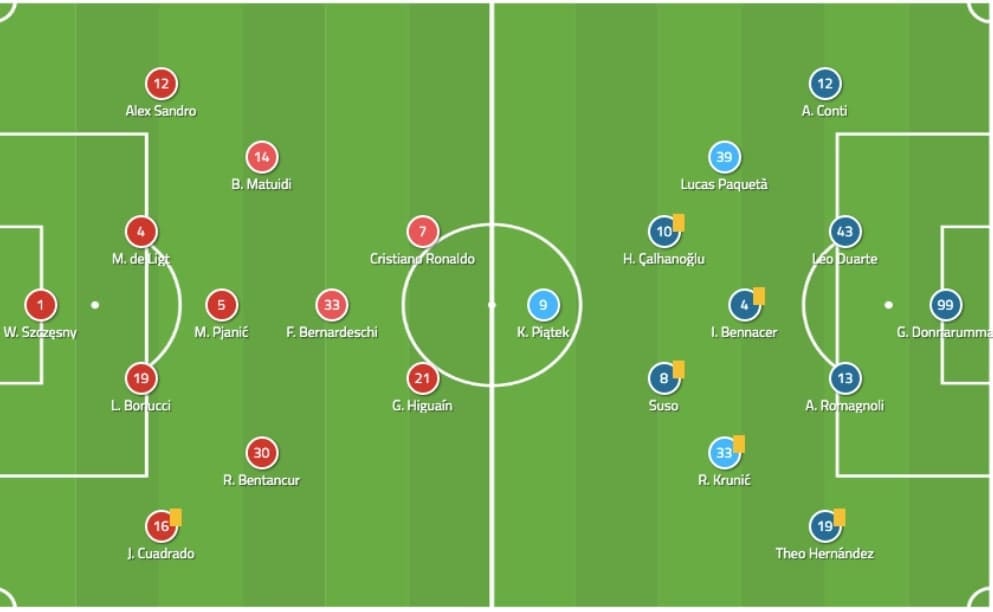
Compared to the team that played Moscow, there were some changes in the Juventus lineup. Daniele Rugani replaced by Matthijs de Ligt. Juan Cuadrado once again played as a right-back, Danilo was on the bench. Miralem Pjanić’s midfield partners were Blaise Matuidi and Rodrigo Bentancur. Aaron Ramsey took a rest, and Federico Bernardeschi played as an attacking midfielder. It was a 4-3-1-2 formation.
Milan also played a team without wide players, in a 4-3-2-1 formation. Davide Calabria was left on the bench, Andrea Conti took his position. Suso returned to the squad, and Samu Castillejo was injured. The Spaniard formed the front three with Krzysztof Piątek and Hakan Çalhanoğlu.
Juventus struggled in their own half
In the first half, Juventus wished to play out from the back as usual. However, they encountered some difficulties since Milan’s pressing. The problem was twofold. First, we explain the defensive setups of the away team.
Milan tried to press Juventus in a 4-3-3 shape. They know the importance of the sole pivot under ‘Sarri-ball’, and their press targeted Pjanić. Suso and Piątek provided pressure around the ball, and Çalhanoğlu was usually the man to mark the Bosnian. Meanwhile, Milan midfielders also followed up to lock the midfield area. They wanted to eliminate options of Juventus players to break the press.
For Juventus, their problem was lacked wide players. Their formation did not have wingers. They should open their shape, stretch the pitch and make opponents difficult to cover all options. If not, they were forced to go wide or play long but this was not secure since they did not have a target man.
In this scenario, the front three and midfielders of Milan did their job, denied Cuadrado from playing the ball out. Since Juventus players were too close to each other, a pass could possibly be intercepted. The key was the positionings of Bentancur and Bernardeschi, they all positioned themselves at the centre, and besides an opponent. Therefore, they were unavailable for a pass. Cuadrado had no choice, he carried the ball wide and play long, lost the possession.
Another point to note was the shape of Juventus, eight of their players were stuck in a tight area. This made them very difficult to move the ball as opponents were defending in a small area. They need the width to stretch the opponents.
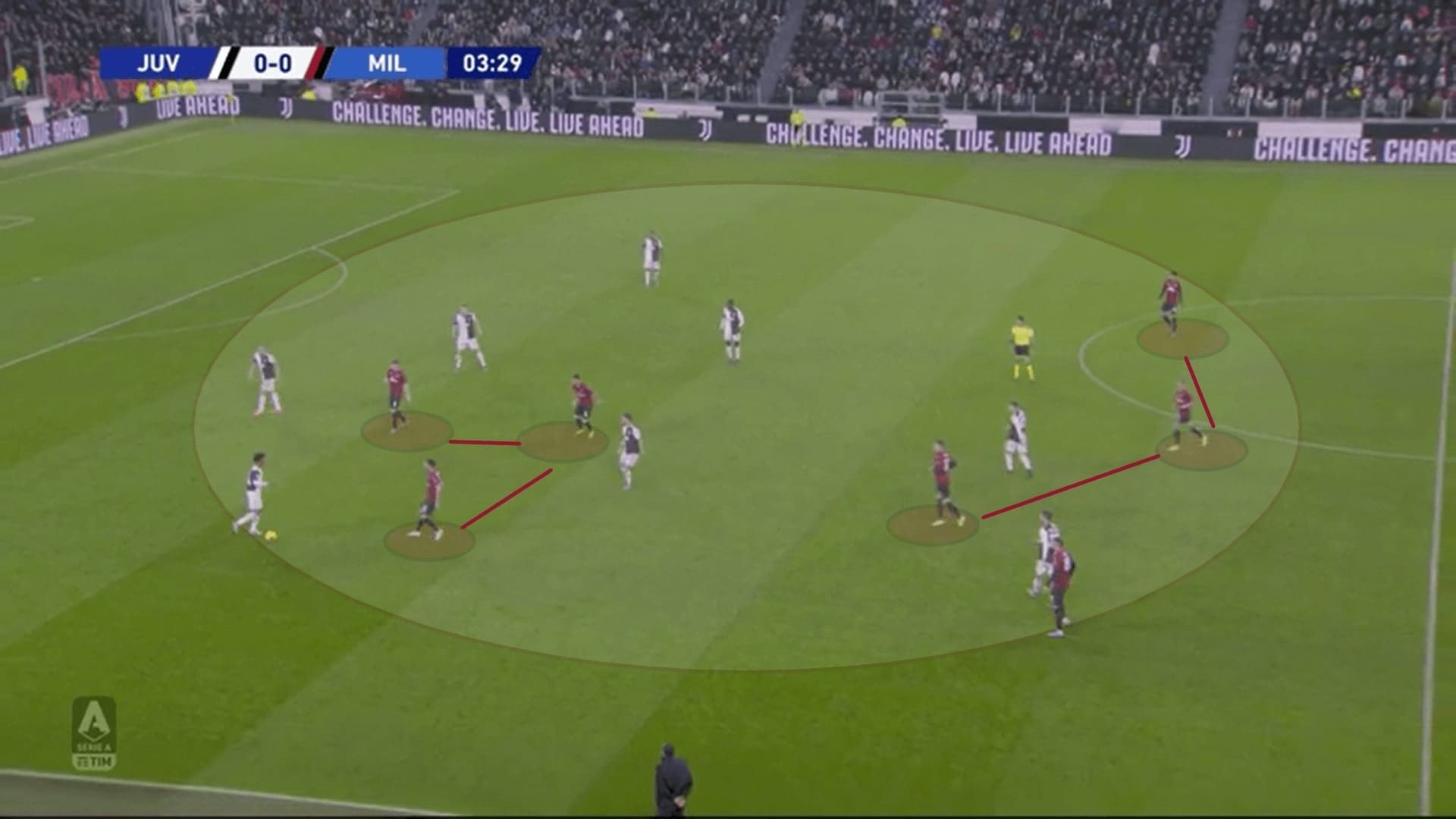
Despite their struggles to play out from their own half, Juventus still got their ways to enter the final third. Their switch plays were good. They could break the press from a side, usually the left, and find a teammate at the weak side. Since Milan pressed in a narrow shape, they left huge spaces at the weak side.
As the below case, which De Ligt spread the ball to Cuadrado. Now, the Juventus right-back provided the width on the right flank. The Colombian was totally unmarked, and he could exploit the huge space at the weak side. The weight accuracy of the pass from De Ligt allowed Cuadrado to enter the final third.
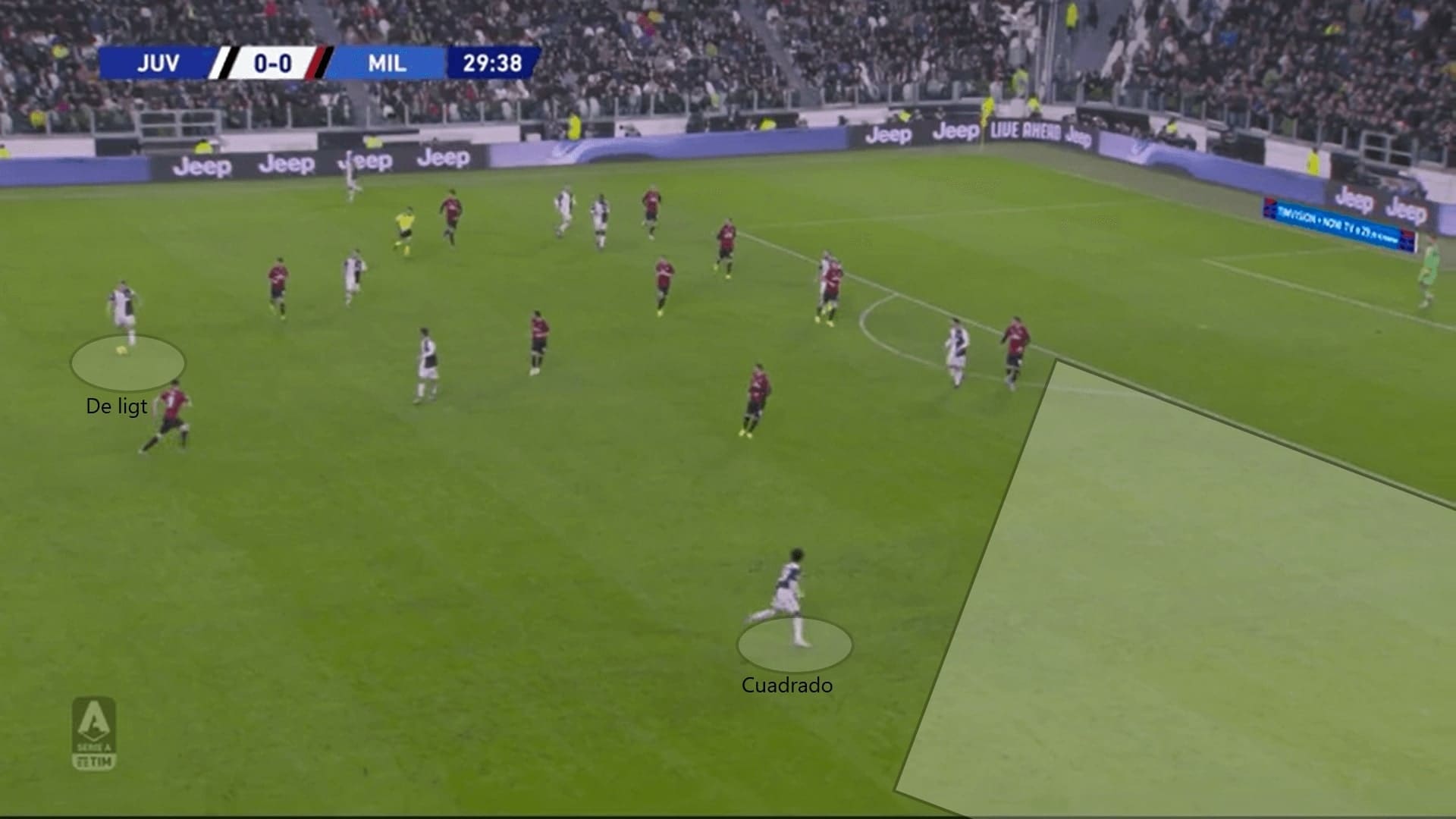
When Juventus reached the final third
In most cases, Juventus switched plays from left to right, and two of the shooting opportunities in the first half were from this flank. Milan was a pressing team, their players often stepped out early to close off opponents, Juventus tried to turn this habit to a weakness of Milan.
Juventus tried to increase the gap between the centre-backs. They did it by some off-the-ball movements of players. First, the ball carrier drew Milan’s left-back Theo Hernández away. Meanwhile, a horizontal or diagonal run from the centre to the right flank could take away the left centre-back, Alessio Romagnoli. Given the poor defensive awareness and protections of midfielders, the third man could run between the centre backs, as Gonzalo Higuaín did. On rare occasions, Milan midfielders cover those spaces.
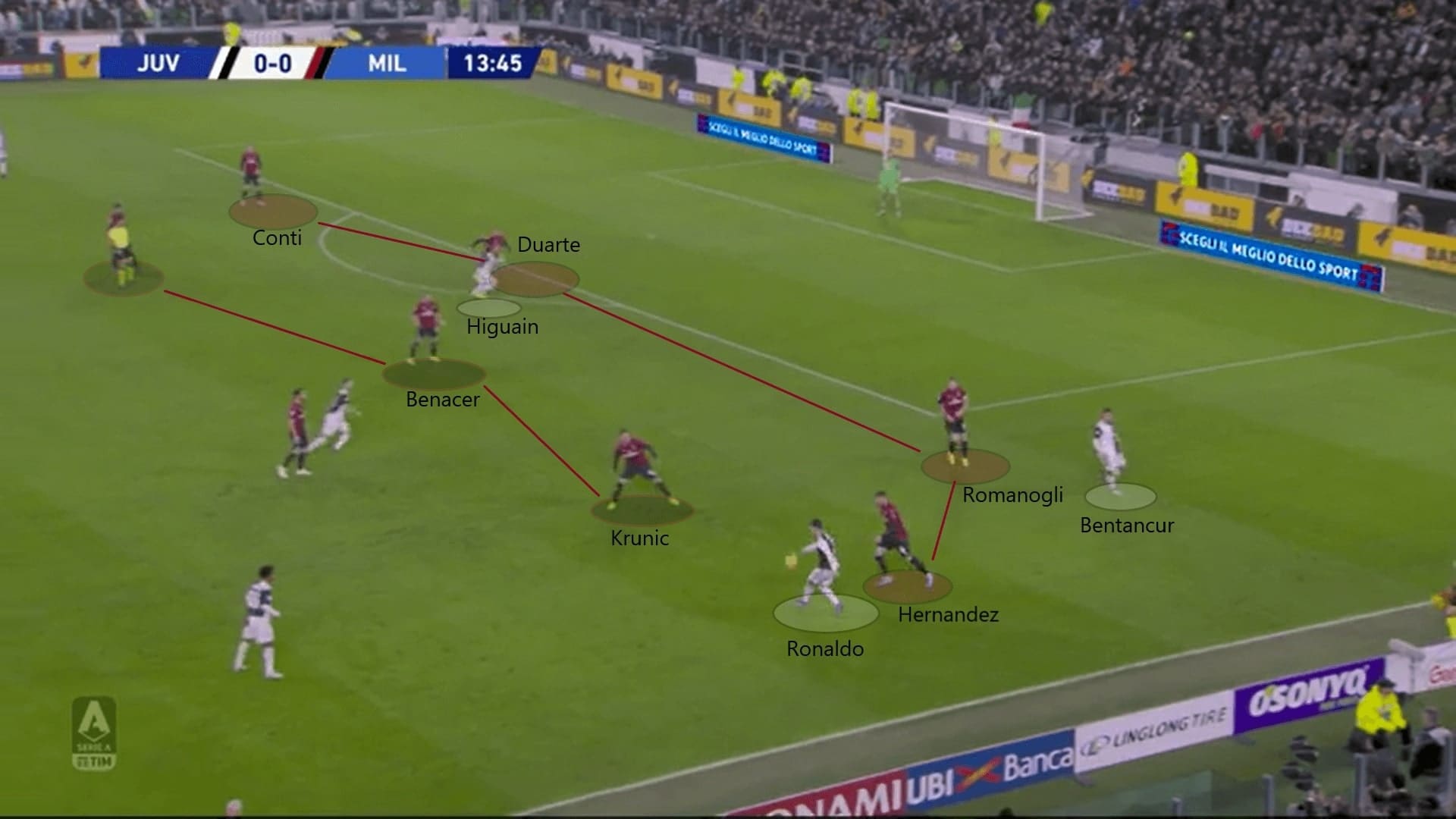
Milan lacked midfield protections
The defensive awareness of Milan midfielders was a concern. They seemed uninterest to track runs, or cover spaces left after their teammates pressed. This weakness of exposed given the third man runs of Juventus. In this case, Lucas Paquetá should have tracked Alex Sandro’s run. However, he just let his international teammate ran behind him. Cristiano Ronaldo released the Brazilian to hit space behind Conti, Romagnoli read the danger and cleared it.
Since Milan had this problem, they were weak to prevent Juventus from penetrating between the lines. On several occasions, Bernardeschi was the free player to make runs behind.
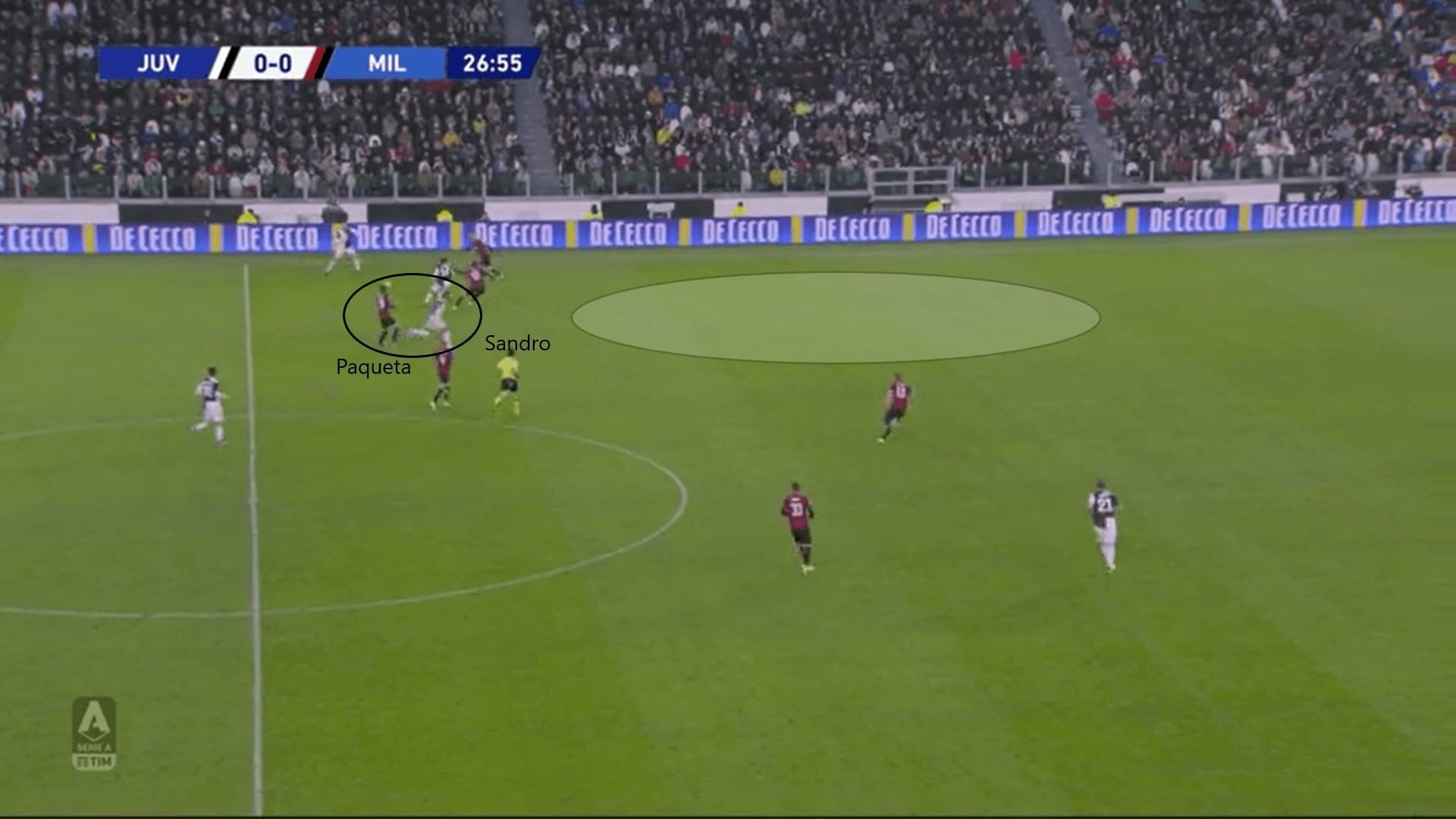
Offensive transitions of Milan
A possible explanation of Milan’s defence setup could be their offensive transitions. The Milan front three were staying high and left huge space for the midfielders to cover since this produced more threat in their counter attacks. Some Juventus players, including Matuidi and Cuadrado, liked carrying the ball forward if Milan intercepted the ball from these players, they created a good moment to counter.
In this case, Paquetá won the ball from Matuidi, and the Milan front three already positioned behind Pjanić. They were ready to sprint forward and hit Juventus with a fast break. Paquetá passed well and picked Piątek, and it was a three against three. The Polish striker’s shot was parried away by Wojciech Szczęsny.
This type of attacks showed Milan’s determination to get forward in offensive transitions, they utilized their chances to hit Juventus as quick as possible.
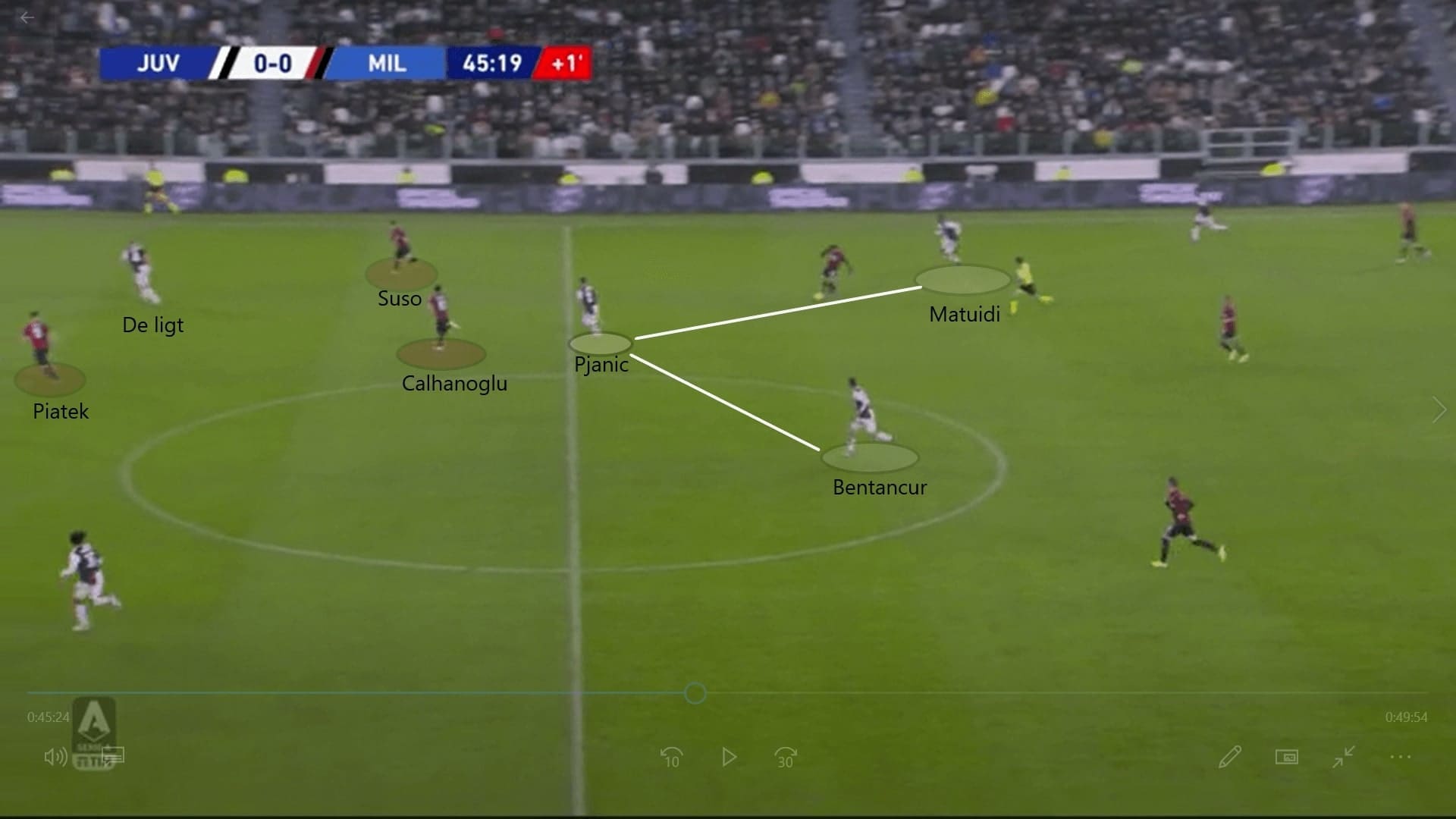
Milan had two sets of build-up plays
Apart from their offensive transitions, Milan also tried to build out from the back. They responded well to the press of Juventus. When pressing high, Juventus stuck to their original shape, 4-3-1-2. Except for the defenders, their players could all take part in the high press. The main idea was to protect the central areas, then closed off opponents when the ball was moved to wide. However, they had their constraints. Ronaldo and Higuaín were 34 and 31 already, they could not commit in intensive high press.
Therefore, Milan could escape from the press, with two different types of build-up plays. The first was demonstrated below, it was a 4-3-3 shape, with Ismaël Bennacer dropped to the centre. In contrast to Juventus’ shape, their full-backs stayed wide, to provide themselves as solutions.
In most cases, Ronaldo and Higuaín positioned themselves between the centre-backs and midfielders. They seldom put pressure on the ball. Bernardeschi should mark Bennacer. Therefore, the full-backs were free, it required a long distance from the Juventus midfielders to close off the full-backs. Also, they created an overload, two v one on this situation. Since Cuadrado did not step up to mark Rade Krunić, Bentancur was confused who to mark.
Hernández took advantage from the confusion of Bentancur, the Uruguayan moved backwards to block the passing lane towards Krunić. This gave the Spanish left-back room to carry the ball forward.
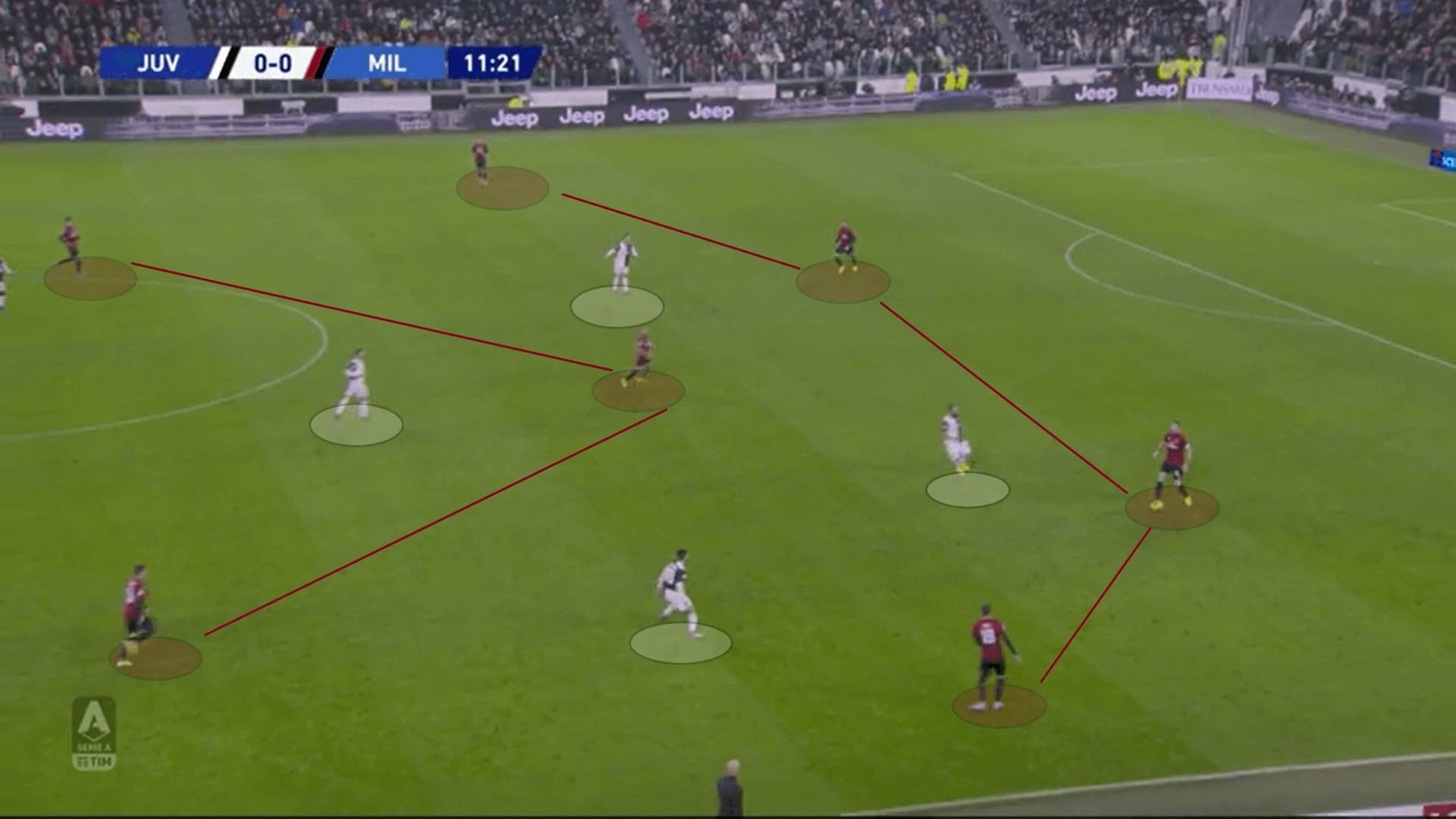
The overload could occur in other parts of the pitch. The below example explained. This time, Juventus commit more players in their high press, just without the defenders. They also remained compact horizontally and vertically to block the centre. Everything seemed fine.
However, this time Krunić dropped beside of Bennacer to create an overload on Bernardeschi and Bentancur. Since the Algerian pinned Bernardeschi, Krunić became the free player. This again forced the Uruguayan to choose between Milan left-back and left midfielder.
The ball was easily played out from the back. When Bentancur decided to close off Hernández, Higuaín was slow to block Krunić and the Bosnian could receive the ball without pressure from the left-back. The press was broken by the passes and positionings of Milan players.
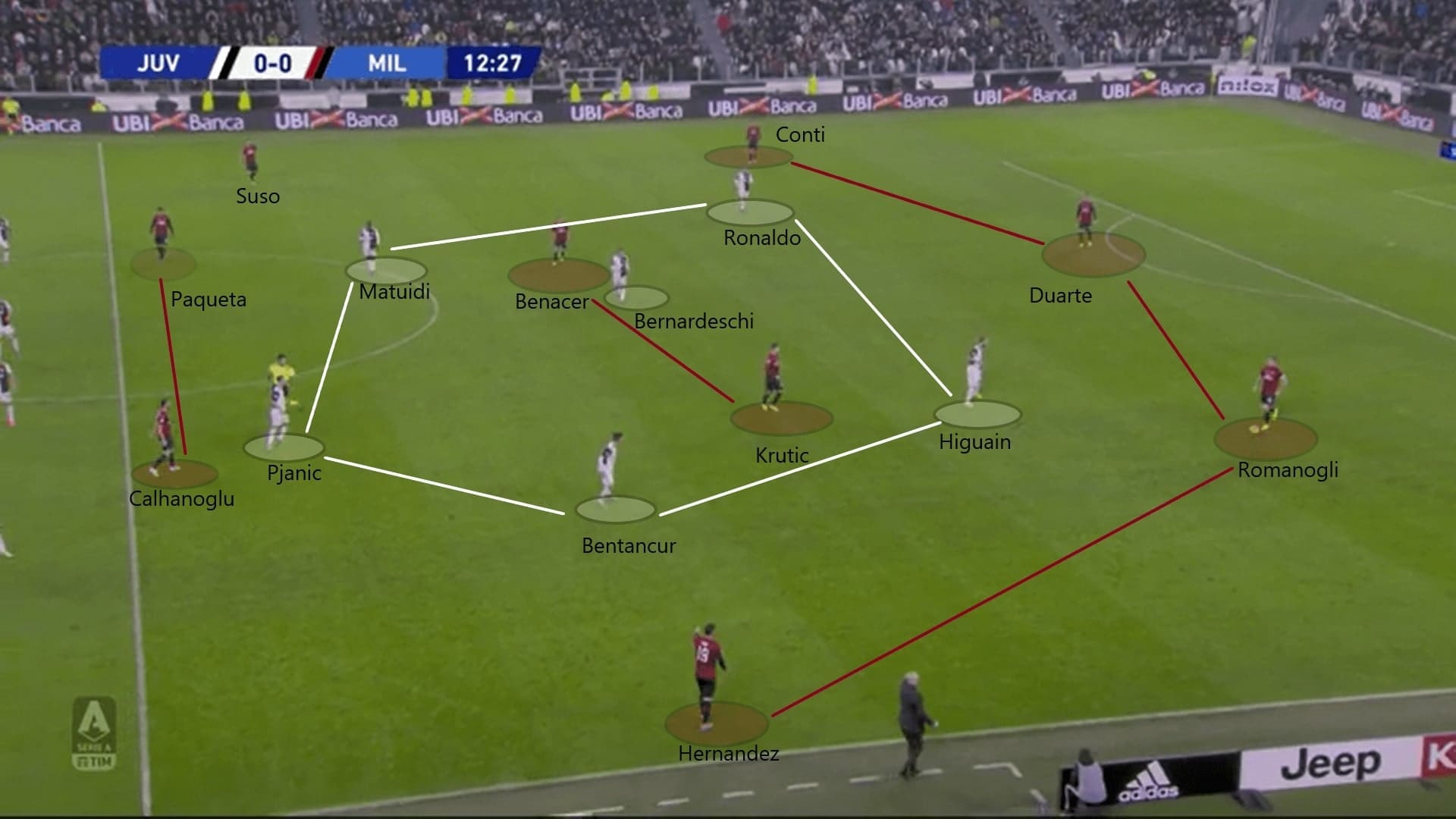
Despite the overloading of Milan players, the failure of Juventus high press could also be attributed to the ineffective press from the strikers. They were not quick and energetic enough to close off opponents or to press and win the ball back. They gave Milan too many rooms to play with.
What happened in the second half?
In this part of the analysis, we focus on the changes Juventus made after the break. Pioli also adjusted his team, which he instructed Suso to stay at a wider position, on the right flank. Given the compact shape of Juventus, Pioli would like the Spanish winger to enjoy some spaces and play diagonal passes for the front players.
In contrast, Sarri’s changes made a bigger impact. He released his attacking midfielder. The player of this position no longer had to stay deeper in the build-up. Instead, he exploited the spaces between lines and connecting plays.
This was shown effective in the below example, which Bernardeschi made himself available between lines. Again, the coverage of Milan midfielders was not enough to protect the central areas, this gave the Italian spaces to receive the ball once Bentancur brought away Bennacer. Then, the former Fiorentina man could turn and this resulted in a shooting chance of Juventus.
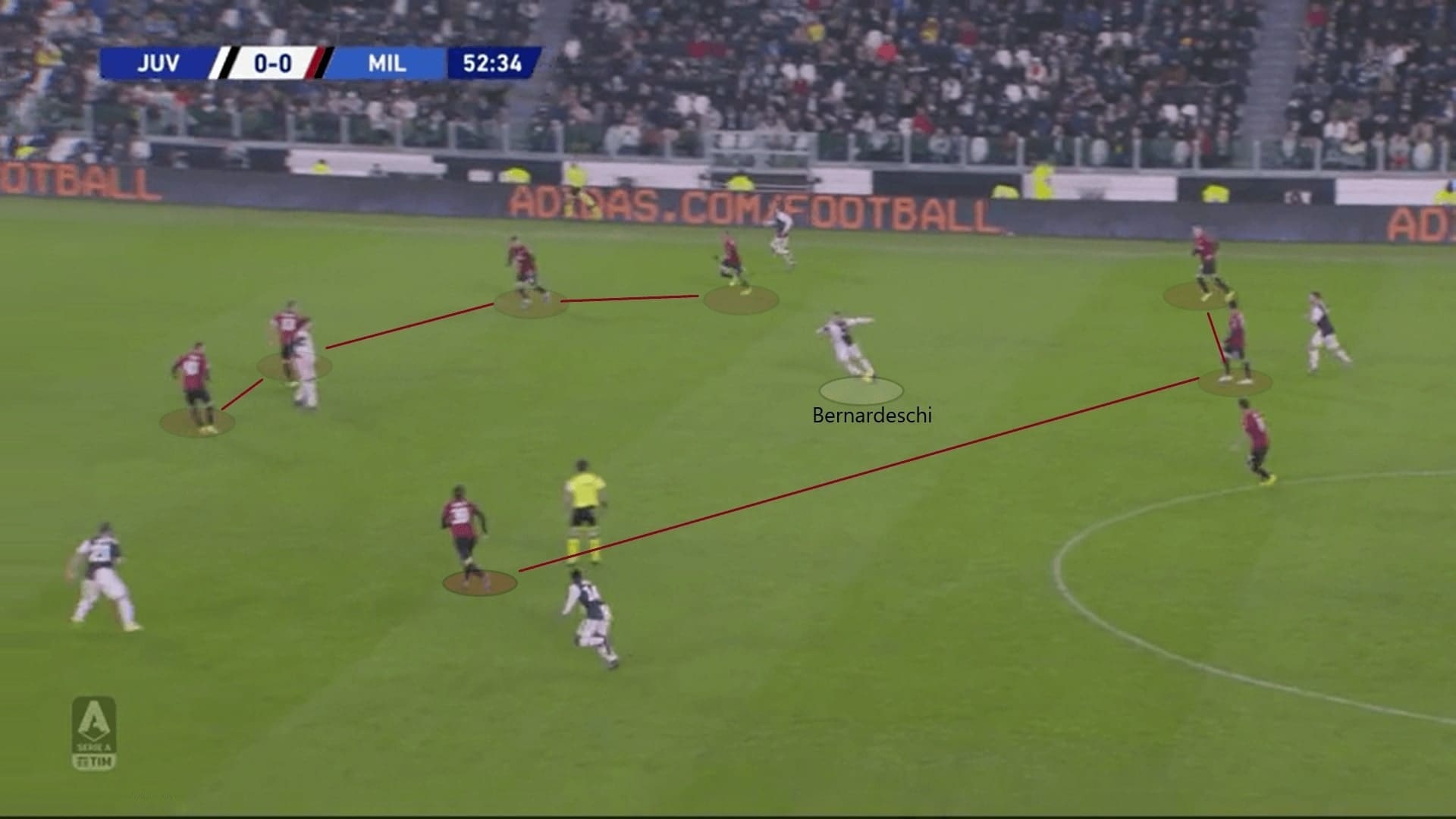
Douglas Costa came on for Bernadeschi, and he did the same. When we considered the elements included in this analysis, this explained how Paulo Dybala scored the winning goal. It was not a coincidence, but a moment of talent from the Argentine and the weakness of Milan defence occurred.
In this scene, Bentancur passed the ball to Costa. Once again, it was poor marking and weak protection of spaces by Milan midfielders. Paquetá did not mark Costa tightly, while Bennacer totally forgot Dybala was behind him. Maybe the Algerian expected Romagnoli would step up and take care of Dybala. This did happen, Romagnoli tried to press him, but it was too late. The Argentine made good use of the space between Hernández and Romagnoli and scored with his right foot.
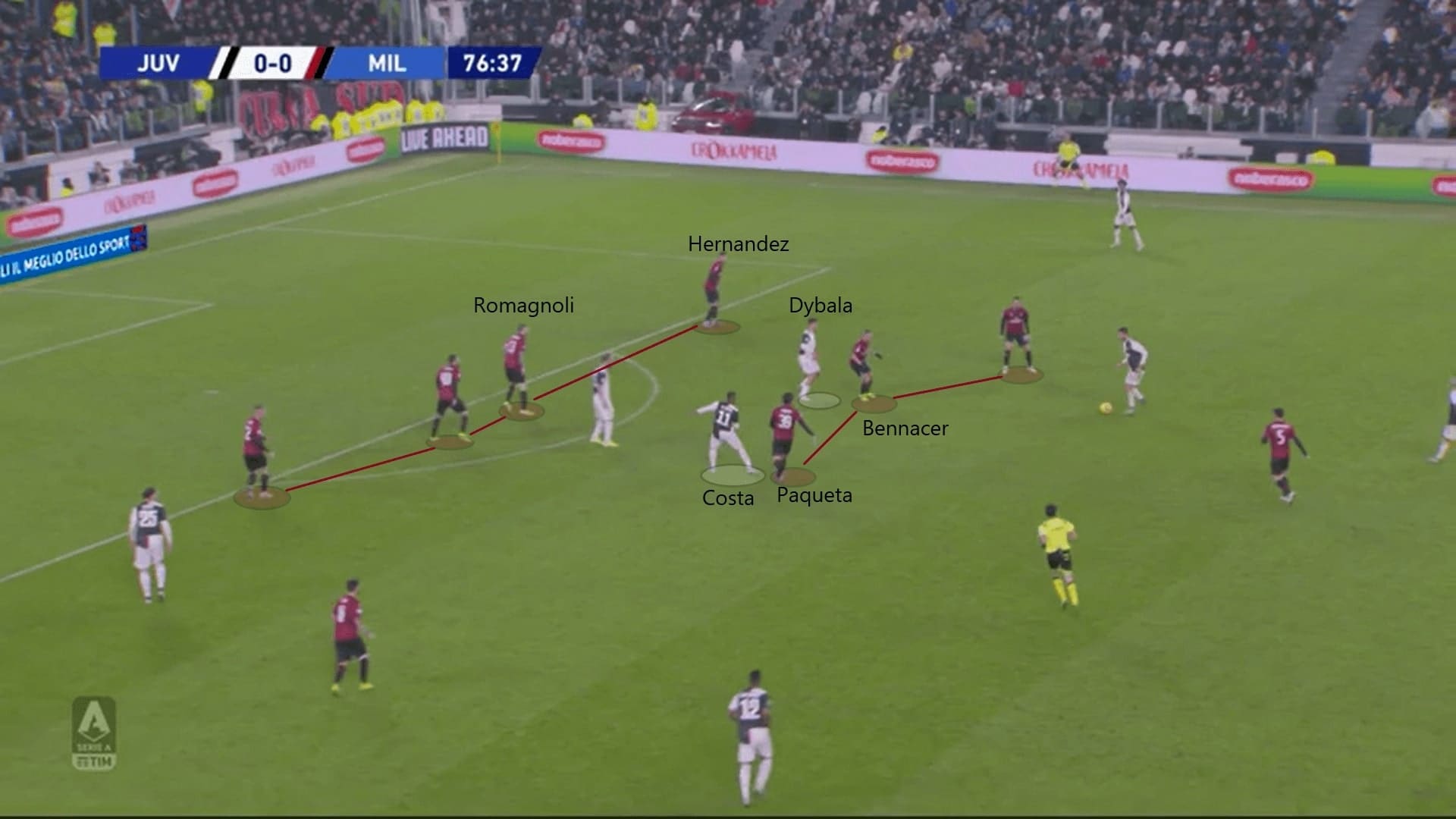
Conclusion
To sum up, it was still yet to be the best from Juventus. It looked they still need time to adapt the system under Sarri. Their control of shape, the build-up plays or positionings of players, still had rooms for improvement. However, they were better in the final third than Milan.
Surprisingly, Milan somehow managed to fight until the end, despite the result was realistic. They tried to play out from the back and managed to break the press on several occasions. Despite the presence of Szczęsny, they still to enhance their quality in the attacking third, and we believe Pioli still got time to improve his team.

If you love tactical analysis, then you’ll love the digital magazines from totalfootballanalysis.com – a guaranteed 100+ pages of pure tactical analysis covering topics from the Premier League, Serie A, La Liga, Bundesliga and many, many more. Buy your copy of the November issue for just ₤4.99 here




Comments